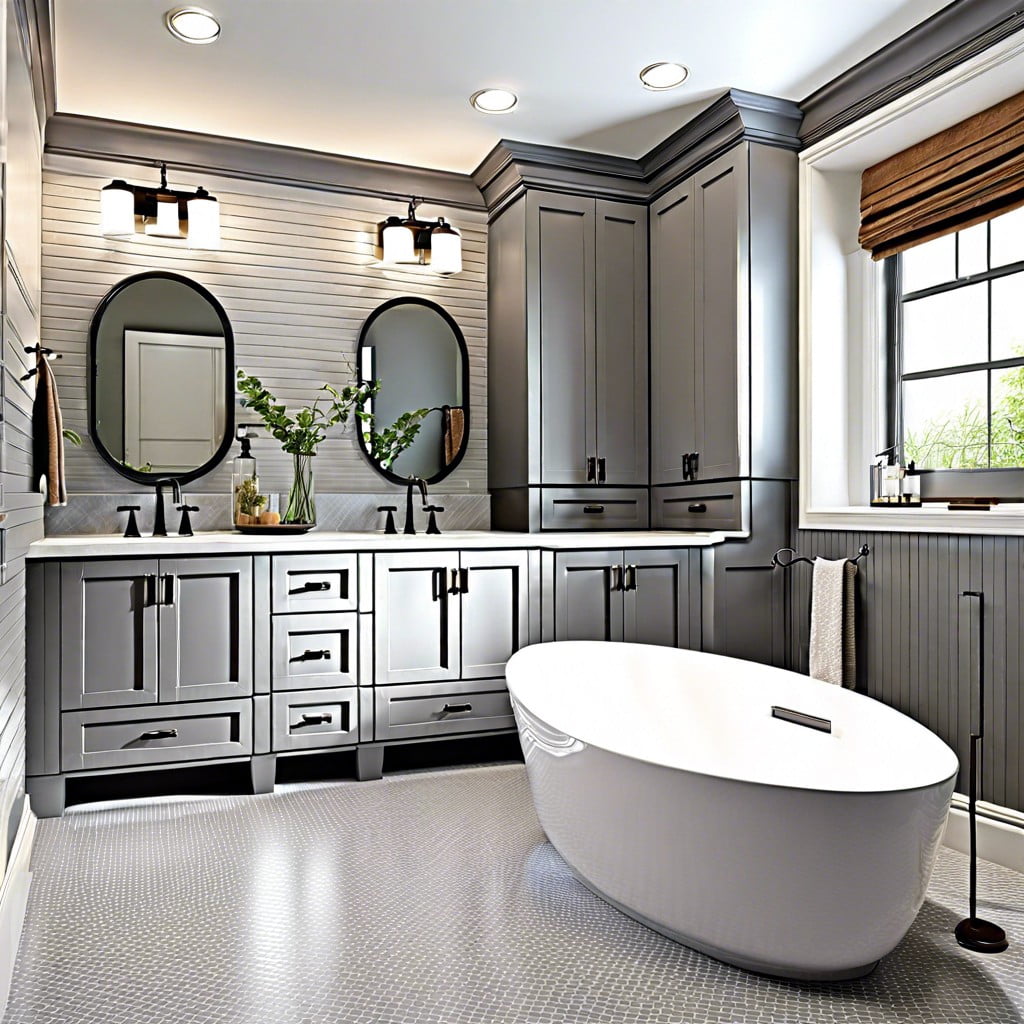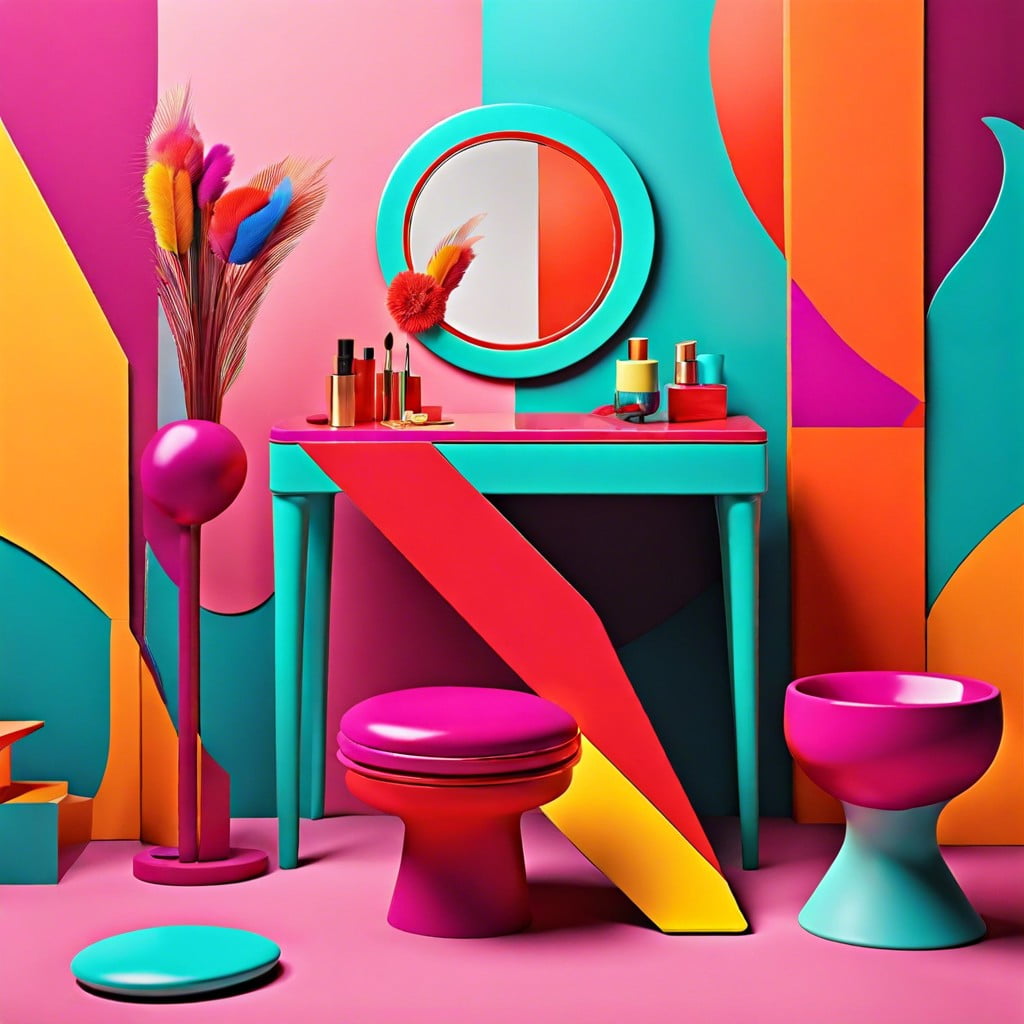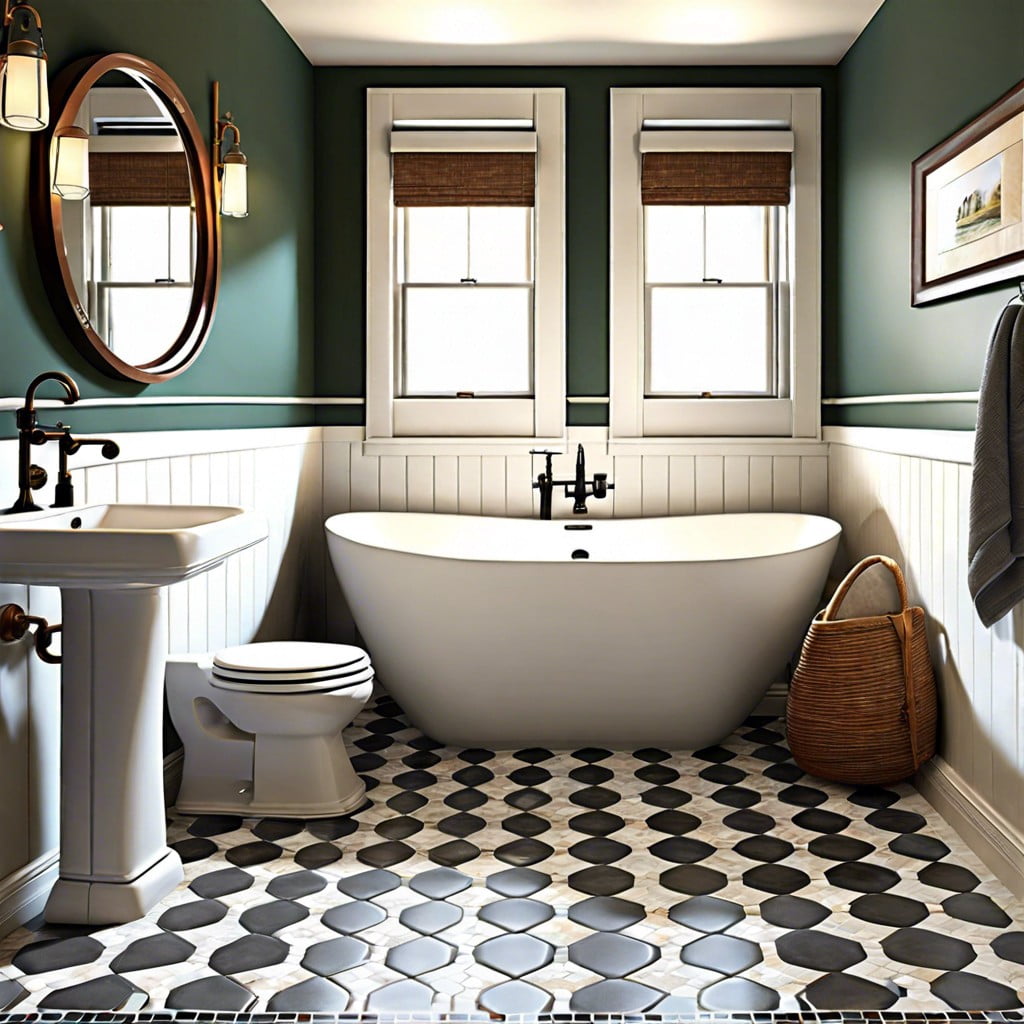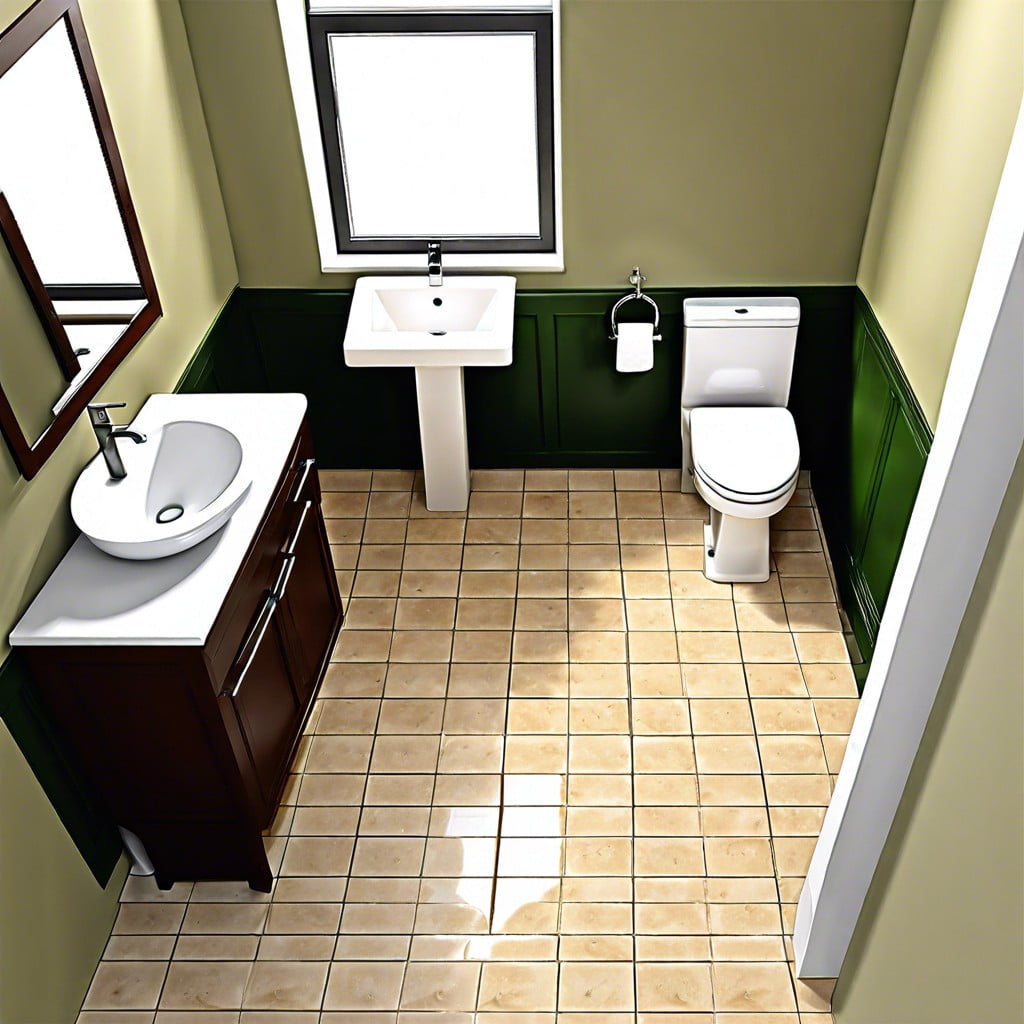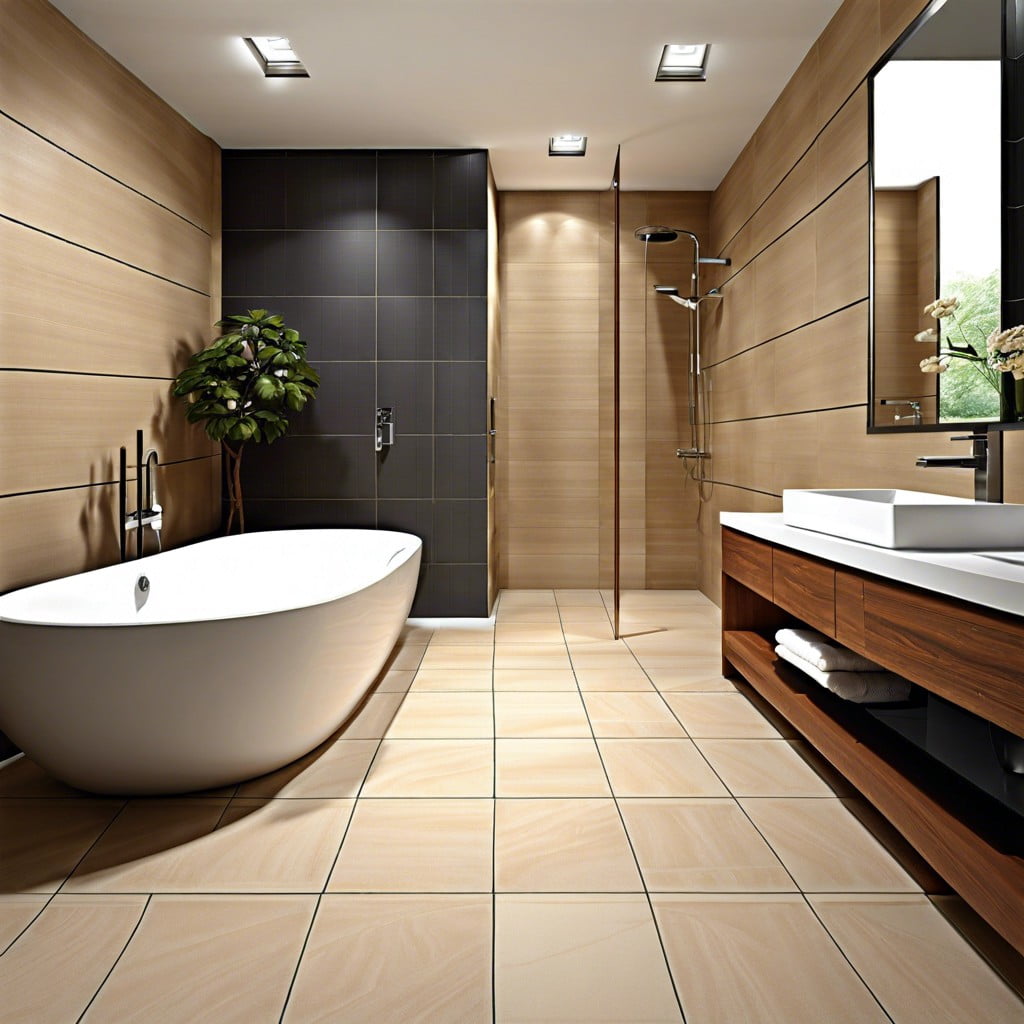Last updated on
Explore the world of shadow decoration because it provides an innovative way to add depth and drama to your space effortlessly.
Shadow decoration can bring a unique and dramatic flair to any home, adding depth and intrigue to your interior design. This article provides a variety of creative ideas to incorporate shadow effects into your decor, from strategically placed lighting and intriguing silhouettes to innovative use of materials and textures.
Whether you’re aiming for subtle sophistication or bold drama, these shadow decoration ideas will inspire you to transform your space into a stylish and captivating dwelling.
Stay tuned to explore all the details and let the interplay of light and shadow reshape your home aesthetics.
Silhouette Wall Art
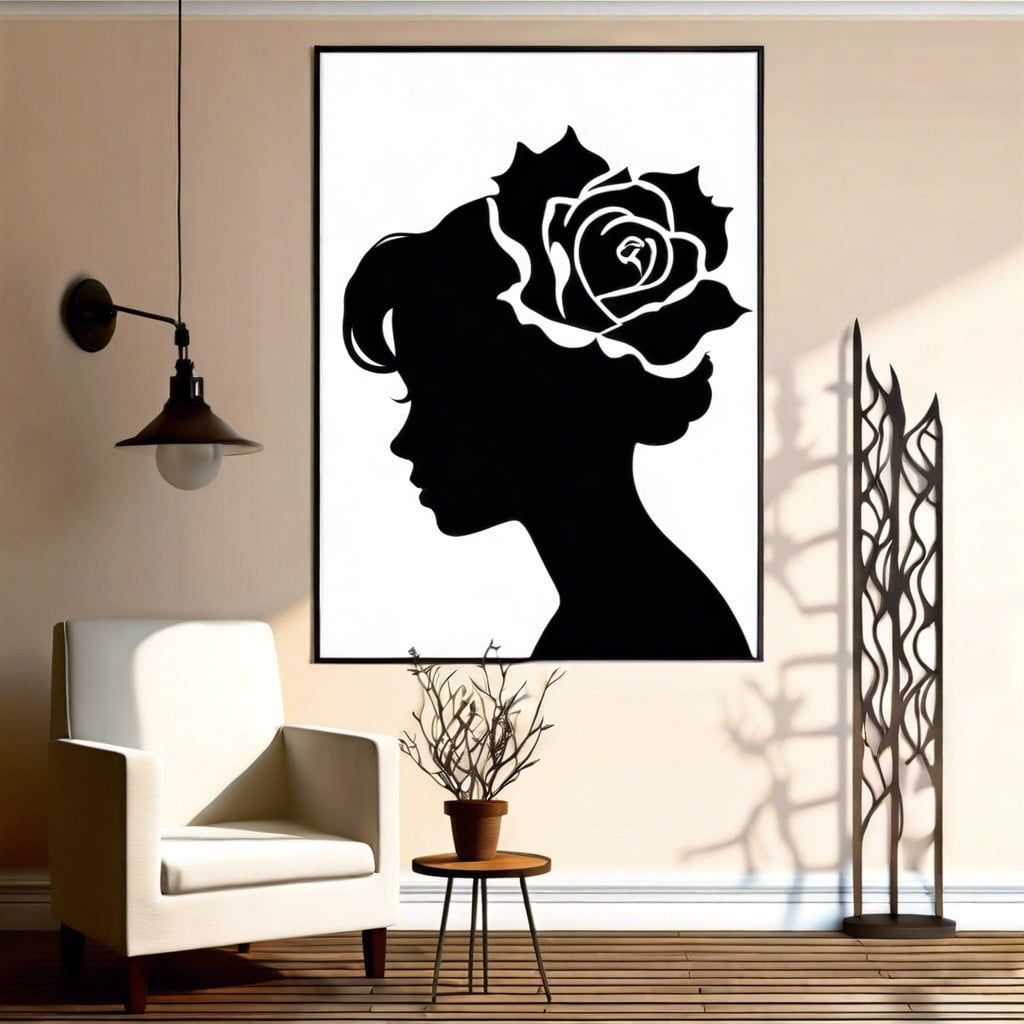
Creating this type of wall art involves framing the silhouettes of various objects such as profiles, pets, or favorite items, transforming everyday sights into stylish designs.
Here are some points to consider when making your silhouette wall art:
- Choose Objects: Opt for items with a recognizable and distinctive shape.
- Contrast: Play with the contrast of colors to highlight the silhouette. Remember, dark silhouettes standout against lighter backgrounds.
- Frame Them: Depending on the style of your room, use ornate or minimalist frames.
- Placement: Placing multiple silhouettes together can form a striking art installation on a large wall.
- Lighting: Direct lighting at the wall art to enhance the silhouette effect and add drama to the space.
Remember, the power of silhouette wall art lies in its simplicity and its ability to add a personal touch to your home’s aesthetic.
DIY Shadow Box Displays
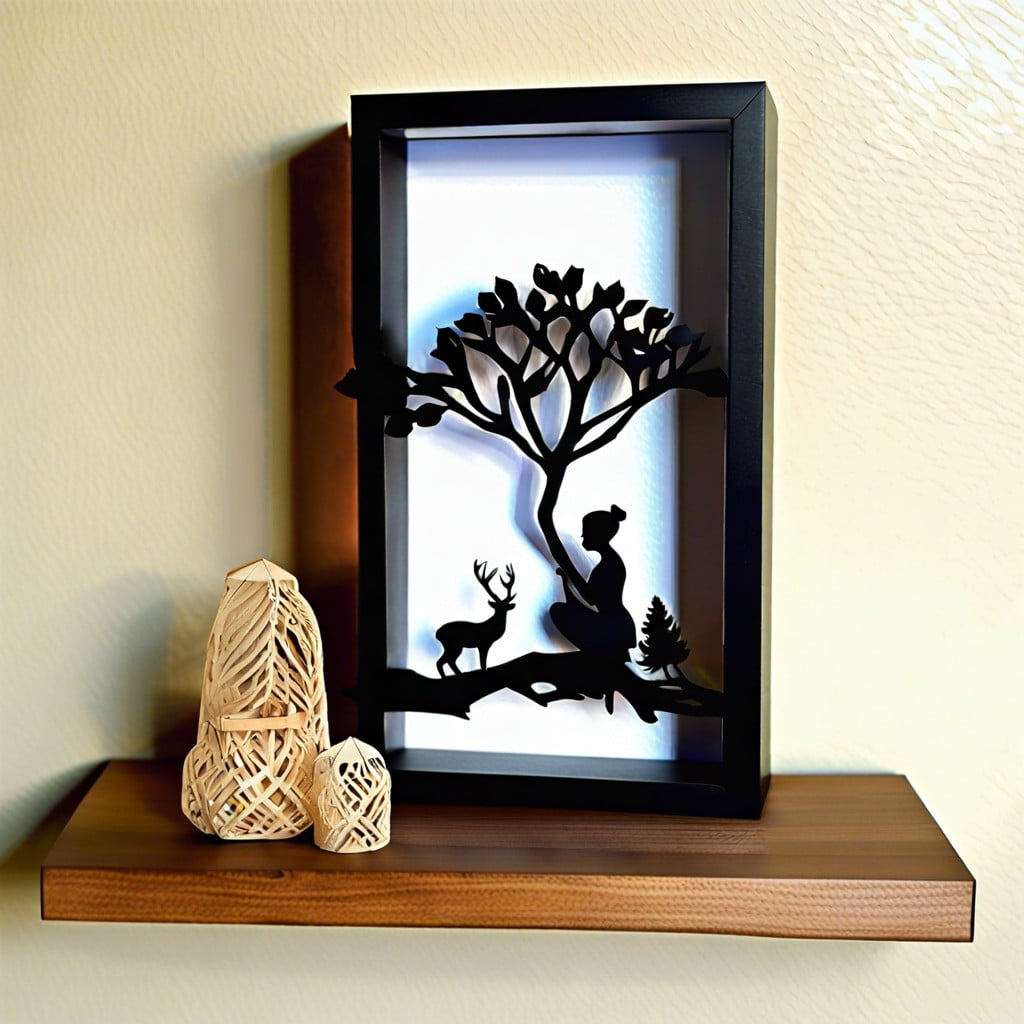
Moving on to DIY shadow box displays, there’s an abundance of creative ways to showcase cherished items. First, select the objects of significance you would like to display. These can be anything from antique jewellery, vacation mementos, vintage postcards, small artwork pieces, to the first baby shoes.
Next, decide on an aesthetically pleasing arrangement. Strive for balance, be it symmetric, asymmetric, or radial. Keep in mind the color scheme and textures, ensuring they complement your overall decor.
Choosing the right shadow box is also crucial. The color and style should complement both the contents and the surrounding decor. Options range from wood to metal frames, or perhaps a recycled old window for a vintage look.
Lastly, neatly mounting your items inside the box is a must. Use pins, glue, or custom-made mounts. The choice depends on the delicacy and weight of the objects. You can even add battery operated lights to emphasize your display.
Remember, your DIY shadow box is not only a stylish addition to your home, but it’s also personal. It tells a story unique to you, frozen in time for your guests to appreciate.
Shadow Puppet Decorations
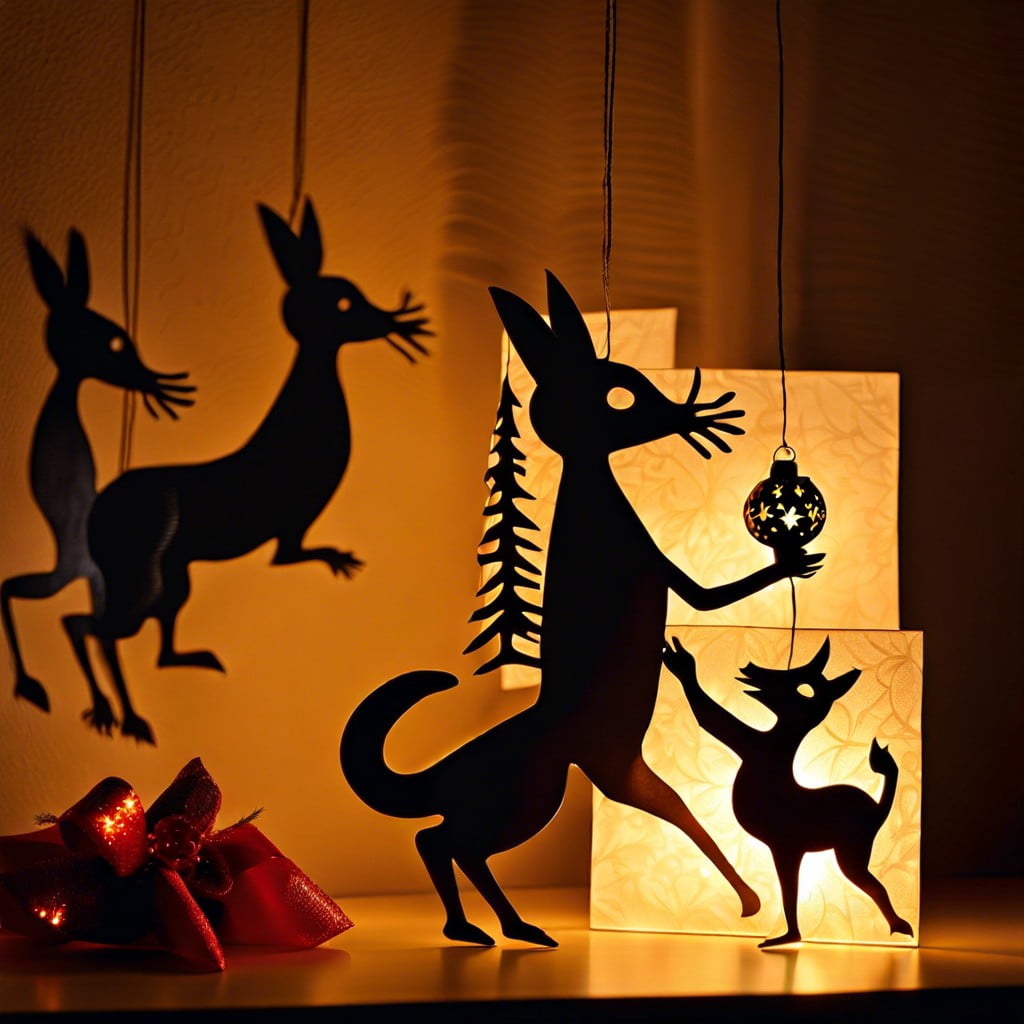
Who knew your childhood fascination with shadow puppets could transition into a playful yet chic home decor option? They’re not just for the kids’ rooms anymore. Here’s how you can put on a permanent shadow play and liven up those plain walls:
- Transform a dull corner with projection of your favorite characters. Use crafted templates or simply hands, deck a lamp with a low watt bulb behind them – voila – an instant shadow mural comes to life!
- Another option is to print out silhouettes of your favorite characters or objects, mount them onto card or cardboard and arrange them in an eye-catching way on the wall. This works perfectly on a painted wall with a contrasting color.
- Glass-paneled cabinet or closet doors can also be used to display amusing shadow images when backlit from the inside. Be it iconic figures, mythical creatures, or your very own creation, it’s sure to be a conversation starter.
- Get creative with materials. Thin metal, paper, old books, even plants can be excellent sources of puppet shadows. Just remember to properly secure them to prevent accidental breaks when someone walks into them.
- Lastly, use LED lights for a modern touch to these traditional shadow plays. Their low heat and sharp light source can create crisp shadow images on your walls or ceilings.
String Lights Shadow Wall
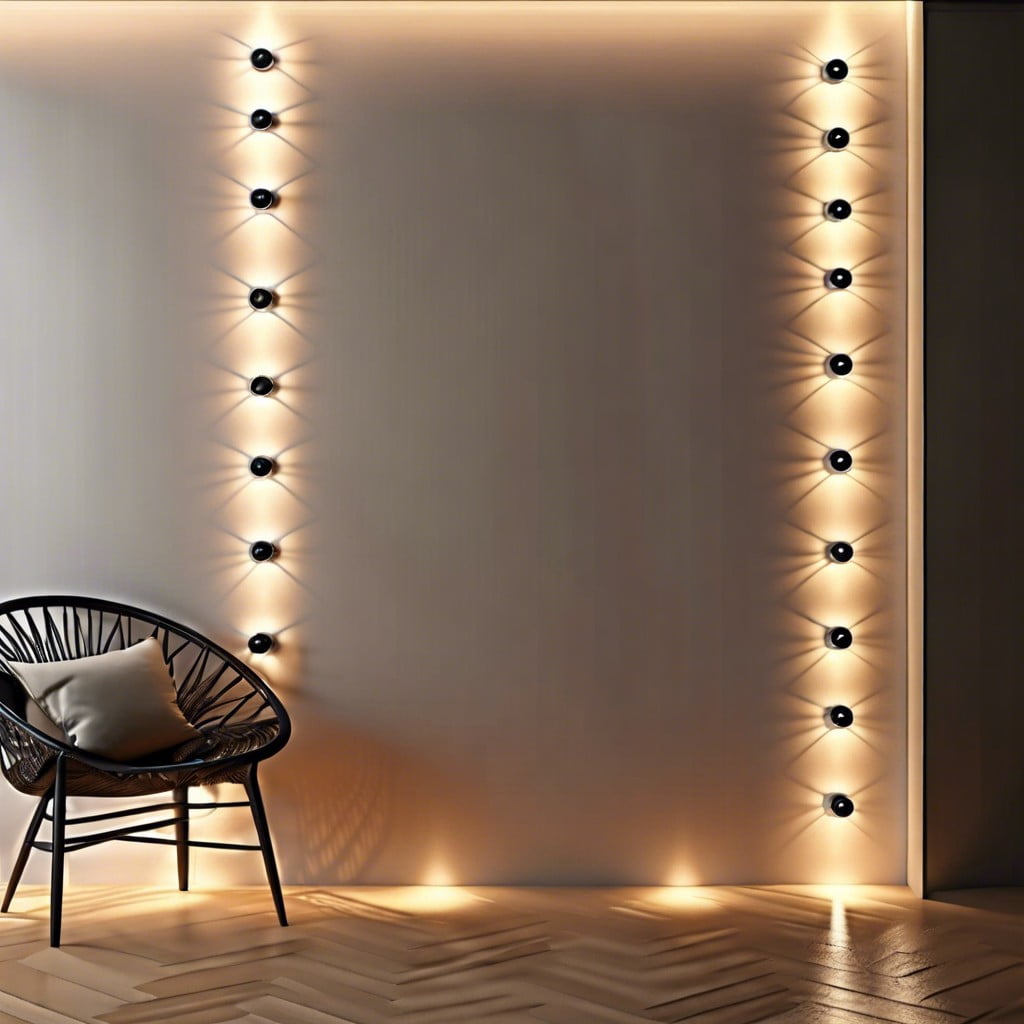
Forging a radiant display in any space, string lights enable you to indulge in the magical glow of tiny lights and their intriguing shadows. Here’s how to maximize this effect:
- Choose the right lights for the atmosphere you want to create; from soft warm lights to colorful LEDs, each gives off a unique shadow.
- Attach the string lights to a wall or ceiling in a pattern that suits your personal style; spirals, zigzags, or even random placement can lead to captivating illumination.
- Try to project the throw shadows onto a blank wall for a clearer outcome; bear in mind that the farther the light source from the wall, the bigger and blurrier the shadow will be.
- Experiment with the placement of lights until you notice patterns that please the eye. Close arrangement for denser patterns; spaced lights for subtle, sparse shadows.
- Adding a gauzy curtain in front of string lights creates a softer, more diffused shadow effect. The fabric texture can alter the shadow pattern, adding an extra layer of intrigue.
- Remember, safety first. Only use lights intended for indoor use, and never leave them on while you’re not at home to prevent potential fire hazards.
3D Printed Shadow Sculptures
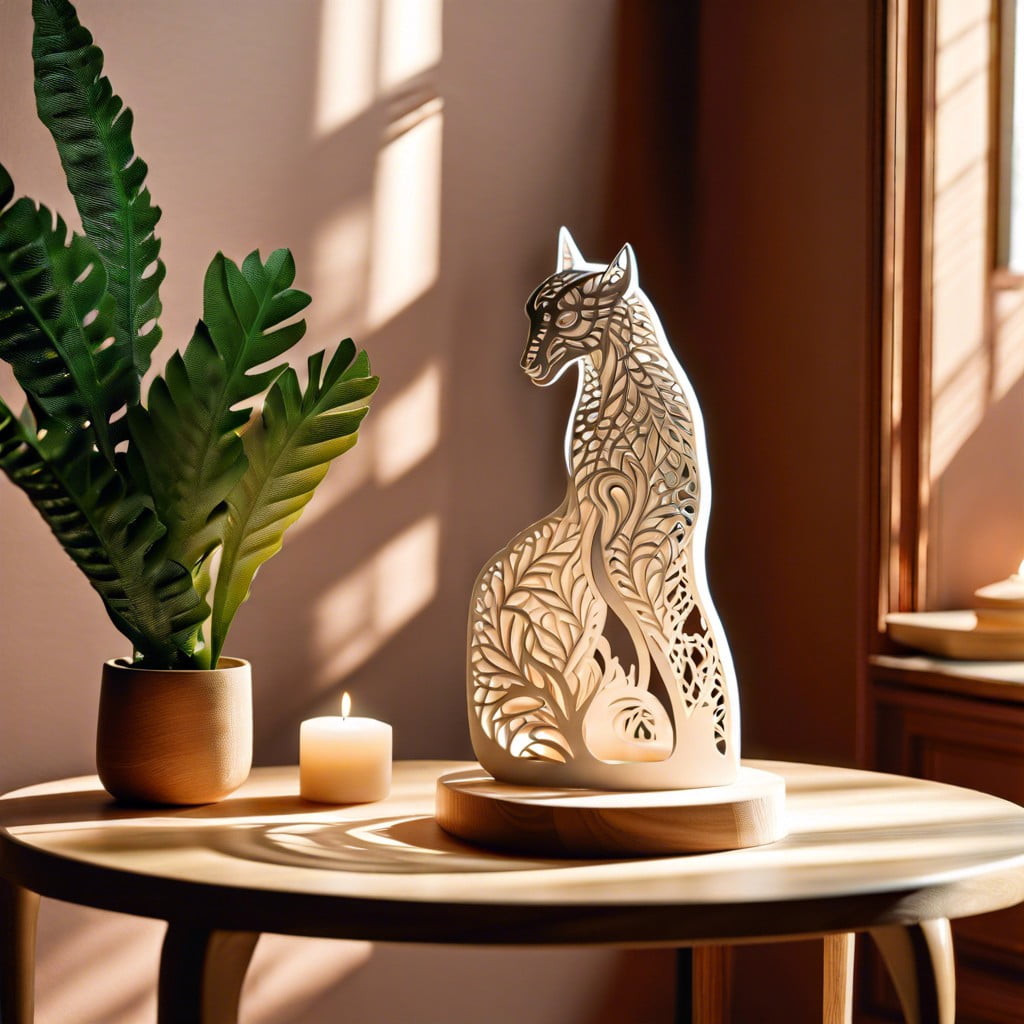
3D printing opens up a new world for shadow decoration. These sculptures, thoughtfully crafted, cast dramatic silhouettes that effectively breathe new life into any space.
Various materials – ranging from acrylic to metal – can be used, allowing for diversity in texture and tone.
Centrality is key – position your sculpture where light hits it directly. Ambient or spotlights, both offer different shadow effects – ensuring the ever-changing play of light and dark.
Size and shape too change the shadow’s intensity; smaller sculptures result in crisp shadows while larger ones form diffuse, subtle silhouettes.
Lover of uniqueness? Custom designs and patterns are available in multitude – from abstract geometrical shapes to intricate replicas and everyday items. Enhanced with illumination, these sculptures command attention and become a conversation starter in your living area.
Themed Shadow Paintings
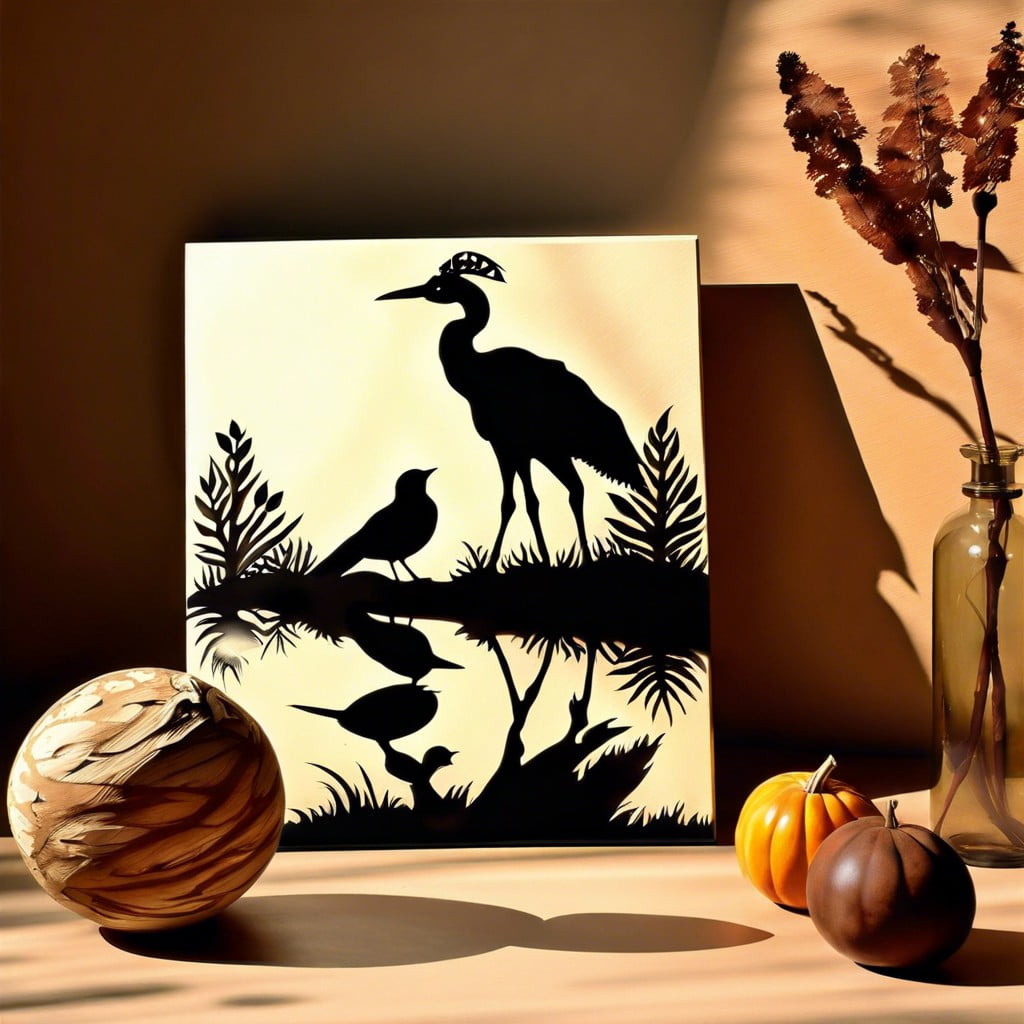
Moving ahead with implementing these shadow-centric themes, remember to blend an interplay of light and dark hues. Inspirations can range from landscapes under moonlight to shadowy city skylines.
Once you’ve picked your theme, you can start by sketching the main elements that create prominent shadows.
Choose indirect light sources to throw defining shadows on your painting. This adds perceptible depth to your artwork. Utilize gray scales effectively to articulate shadow parts and illuminate highlights, thus achieving a photorealistic appeal.
Not all shadows are black, remember that. Depending on the strength and color of the light source, alter your palette accordingly. A sunset-themed painting, for example, may produce warmer, softer shadows in contrast to the stark silhouettes reflected in a moonlit night scene.
Ready-made stencils can also be used for complex shapes. This eliminates the struggle of perfect proportions and gives a neat look. Incorporate these tips to craft thematic shadow paintings that are sure to mesmerize viewers with their dramatic interplay of light and darkness.
Plant Shadows On Walls
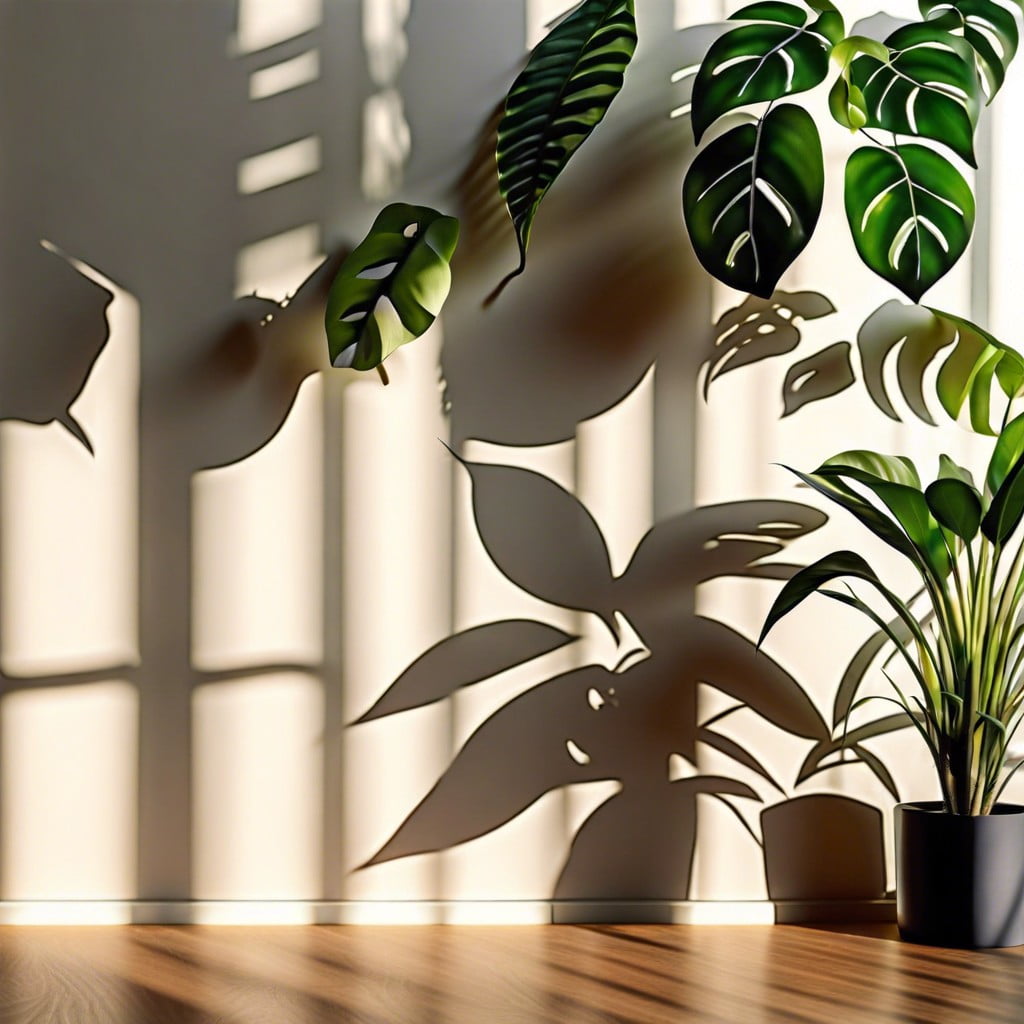
Taking advantage of natural elements like indoor plants creates enchanting wall art. The concept gravitates around adjusted positioning of plants relative to the light source, projecting artistic shadows on adjacent walls.
Here’s how:
- Choose Wisely: Leafy and intricate plants make the most captivating shadows, so consider ferns or cheese plants.
- Light Matters: An adjustable light source like a spotlight or table lamp allows you to control the shadow’s intensity, size, and direction.
- Experiment: Aim the light source directly at the plant from different angles to vary the shadow design.
- Strategic Positioning: Place the plant on shelving or a side table to enhance the light’s work.
- Harmony: Use a wall color that complements the color of the plant and the room’s overall theme for an integrated look.
Remember, the changing nature of the plant and the shifting light throughout the day will keep your shadow decoration ever fresh and stunning.
Shadow Chandelier Designs
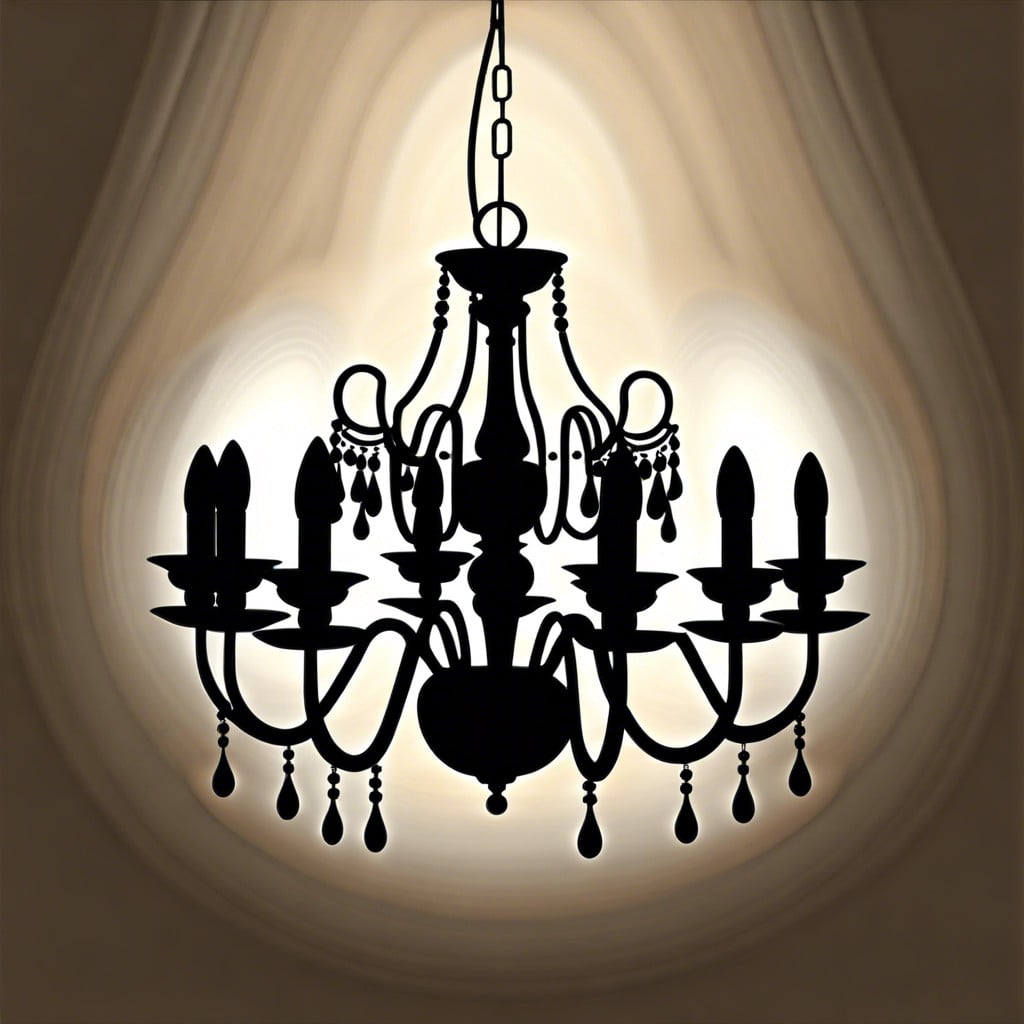
Using varying heights, shapes, and materials, a shadow chandelier takes lighting design up a notch. It’s not solely about the illumination it produces, but the stunning shadows cast on the walls and ceiling.
Here are a few points to consider:
- Pick complex designs to enhance the shadow play. Opt for geometric shapes or intricate patterns, such as filigree, for a more dramatic effect.
- Material choice is crucial. Materials like wrought iron or cut-out metal produce crisp, well-defined shadows.
- Think about bulb intensity and color. Brighter, whiter light intensifies the shadow, while a softer, warmer result is given by a more dimmed light.
- Position is pivotal. Angled correctly, one can maximize the impact of shadows on the desired areas.
- Administer an occasional dusting to keep the chandelier and resultant shadows sharp and bright.
Remember, a well-placed, well-designed shadow chandelier can dramatically elevate any room’s ambience.
Floating Shelves With Shadow Effect

Placing the shelves in areas where they can cast interesting and eye-catching shadows is key. Consider spots that receive plenty of natural or artificial light. Shadows become part of the decor when they play with shapes and forms on the wall behind. For more drama, paint the wall a contrasting color, allowing the shadows to standout.
Employ irregularly shaped shelves or shelves with cut-out patterns to generate intriguing shadow effects. Remember, the changing light throughout the day can bring a dynamic decorating element to the space. Lighting directional spotlights downwards onto the shelves can amplify the shadow effect during evenings. Just be sure to carefully calibrate your light source to achieve the desired shadow intensity and shape.
Balance the items displayed on your shelves; too many items can clutter the effect. Finally, maintain a minimalist approach concerning the items you display, keeping the focus on the beautiful shadow play.
Shadow Photography On Decor
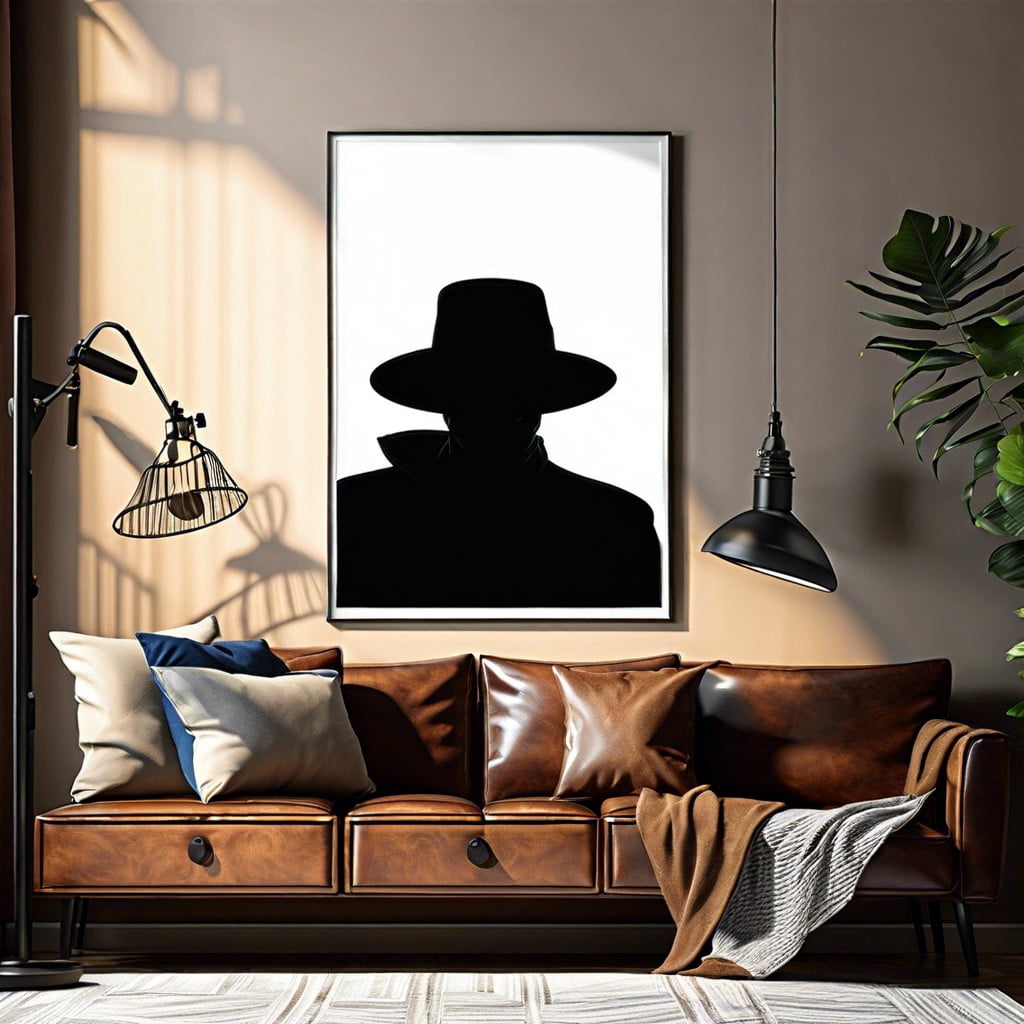
Harnessing the power of light and dark, shadow photography can dramatically accentuate the decor. To create a striking impact, here are some ideas:
1. Position a centerpiece object strategically near a light source, capturing the intricate shadow patterns it casts on walls, ceilings, or even other furniture pieces.
2. Black and white shadow photography prints can bring depth and contrast to a room. Opt for shots with strong geometric lines or natural elements for a compelling aesthetic appeal.
3. Use translucent curtain layers to throw soft, diffused shadow patterns during the day. Capture these visual effects in a photograph to create a peaceful ambiance.
4. Place a mirror in the path of the light source to refract and scatter the light, creating captivating multiplicities of shadow in your picture.
5. Experiment with colored light sources. This adds a playful or mysterious depth to a shadow and breaks away from traditional monochrome trends.
6. Manipulate varying degrees of light intensity to construct a gradient shadow effect in your picture.
Remember, shadow photography is about capturing the absence of light in an artistic way. The photos in themselves are achievements of creative exploits, but when incorporated in your decor, they contribute to a dynamic and intriguing living space.
Creative Shadow Murals
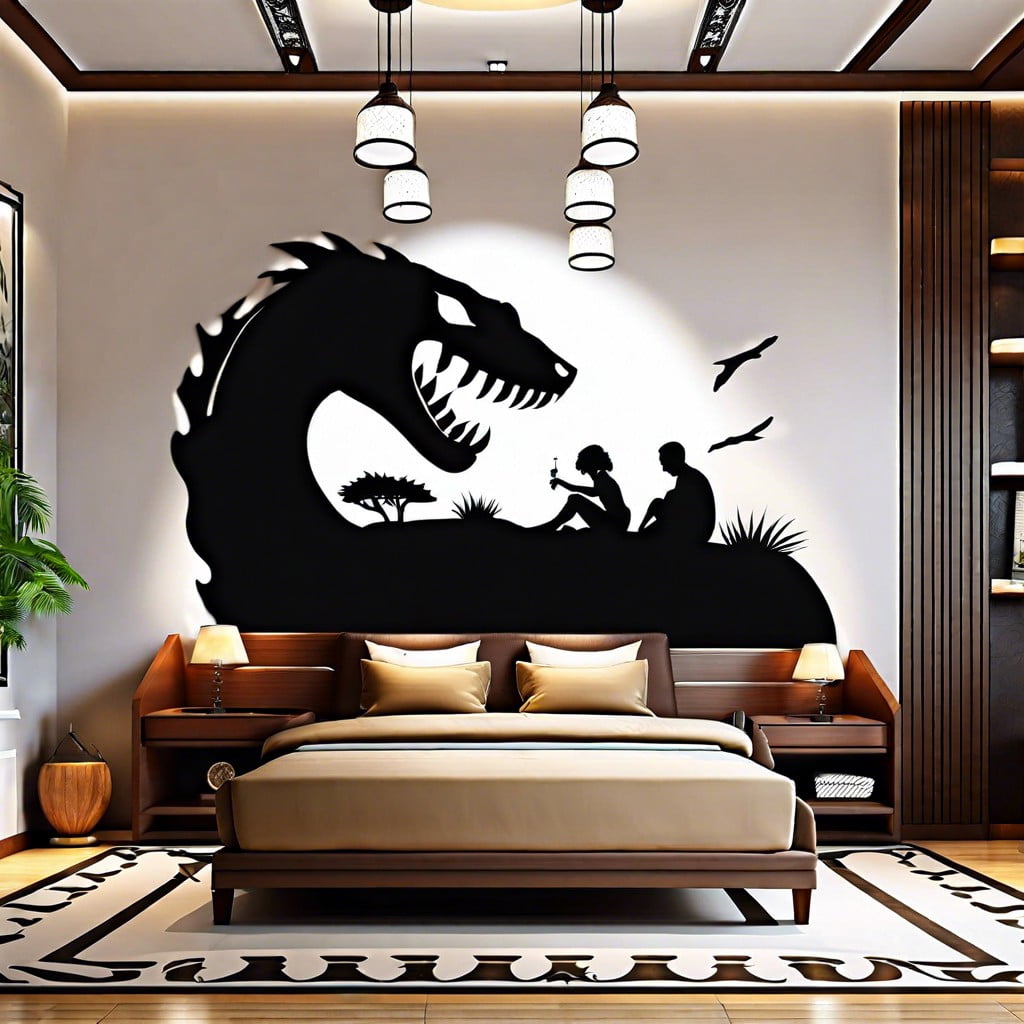
Leveraging different lighting, angles, and three-dimensional objects can yield stunning murals that cast intriguing shadows. Enhance your living space with these simple steps:
1. Choose a wall: Find a wall that gets abundant light during the day or could have a light source placed opposite to it.
2. Select an object: 3D objects are best for this. You could use a sculpture, a bicycle, a mannequin, or anything with an interesting shape.
3. Positioning: Place the object in a way that the light source, whether natural or artificial, shines directly onto it, creating a distinct shadow on the wall.
4. Paint the object’s shadow: Using a color that compliments the wall, fill in the shadow shape.
The total effect would be a dynamic mural that changes with light throughout the day, adding a unique touch to your home decor.
Shadow Art With Metal Accessories
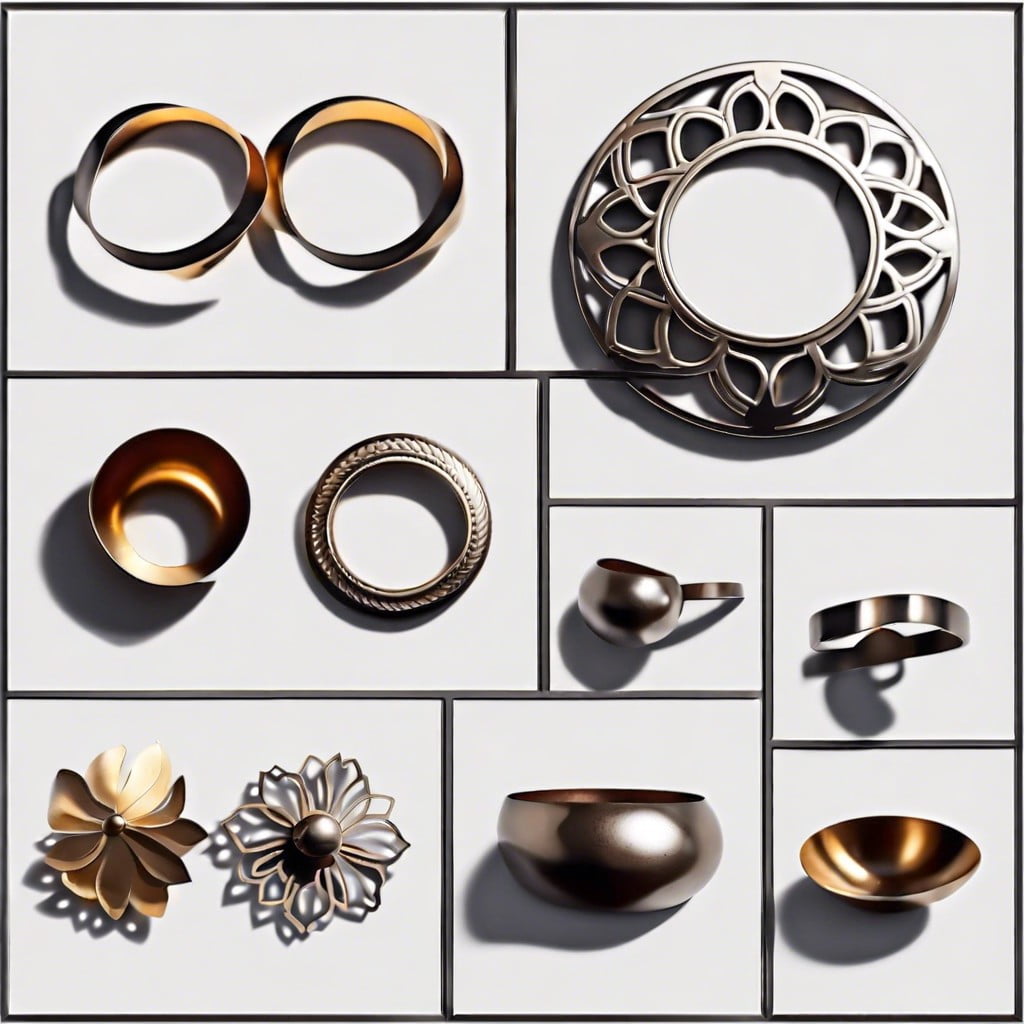
Selecting metallic materials helps in creating striking displays as their natural tendency to reflect light results in amazing shadow art. You can experiment with crafted iron jewelry holders, twisted bronze sculptures, or even copper kitchen utensils in an innovative twist. Any metallic piece with a unique shape or silhouette can be used here.
Ensure to hang or position these pieces where natural or artificial light can hit them. The cast shadows will dramatically change throughout the day with the sun’s movement, introducing a dynamic element to your decor.
A top tip is to use softer metals such as copper or brass as they can be reshaped in different forms, allowing your shadow art to evolve over time. Lastly, remember the shadows formed will have the most detail near the light source, so experiment with lighting to achieve optimal results.
Rustic Shadow Decor With Antiques
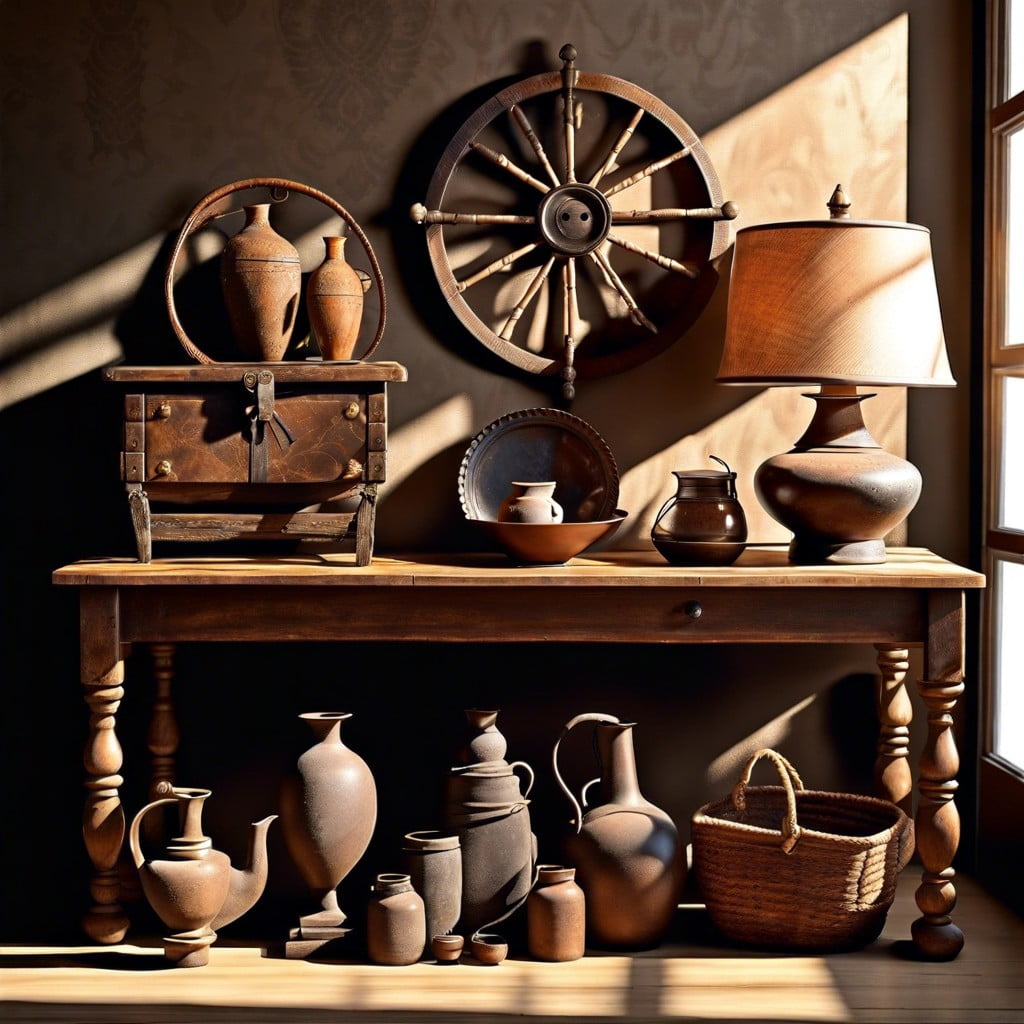
Antiques can offer an excellent medium for creating rustic shadow decor. The intricate designs and textures of these aged pieces cast unique shadows that add an element of depth to your room. Utilize soft, ambient lighting to accentuate these shadow effects, resulting in a vintage yet dynamic visual appeal.
1. Positioning: Opt for place settings where the light source (natural or artificial) can create the best shadow effects based on the shape and design of the antique.
2. Mix and Match: Pair different antiques of various sizes and designs to produce a variety of shadow patterns.
3. Light Adjustment: Experiment with light intensities. Soft, ambient lights can create fuzzy shadow borders, while harsh lights can result in crisp, defined shadow lines.
4. Balance: Ensure you maintain a balance between the rustic decor and contemporary elements of your room to avoid appearing outdated.
5. Incorporate Mirrors: Mirrors not only create an illusion of space, but when placed strategically, can also reflect and multiply the shadow effects, enhancing the vintage settings.
Implementing these points can vastly elevate the aesthetic appeal of your space, adding a touch of rustic charm without sacrificing modern sensibilities.
Silhouette Family Portraits
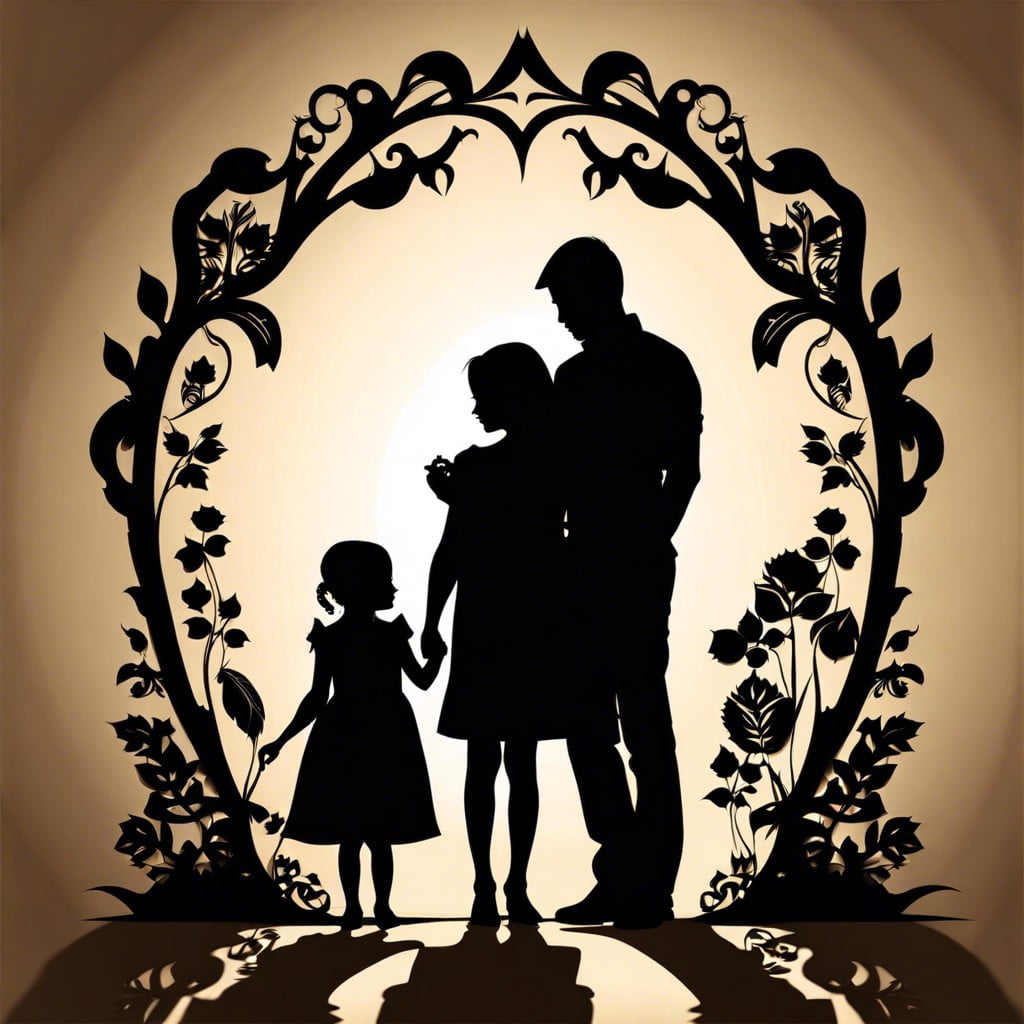
Bring your family’s unique contours to life with this clever concept. Use profile pictures of each member to create simple, stark silhouettes. Convert these photos into black and white images to bring out a clear outline, transferring them onto a sturdy piece of paper.
- “The Right Lighting:” Ensure the profiles are against a light background to enhance the outline in the final image.
- “High-Contrast Photography:” Use photo editing software to adjust the contrast in the image. Maximize the contrast for a clean, clear silhouette.
- “Crafting the Artwork:” Trace the image onto a coloured or patterned paper of your choice using transfer paper, then carefully cut around the outline.
- “Show Off Your Art:” Finally, frame each silhouette separately or together on the same surface, creating an artistic visual history of your family.
Remember, you can experiment with colours, sizes, and patterns to add a personal touch. Check out online tutorials for more detailed instructions and ideas.
Shadow Stencil Wall Art
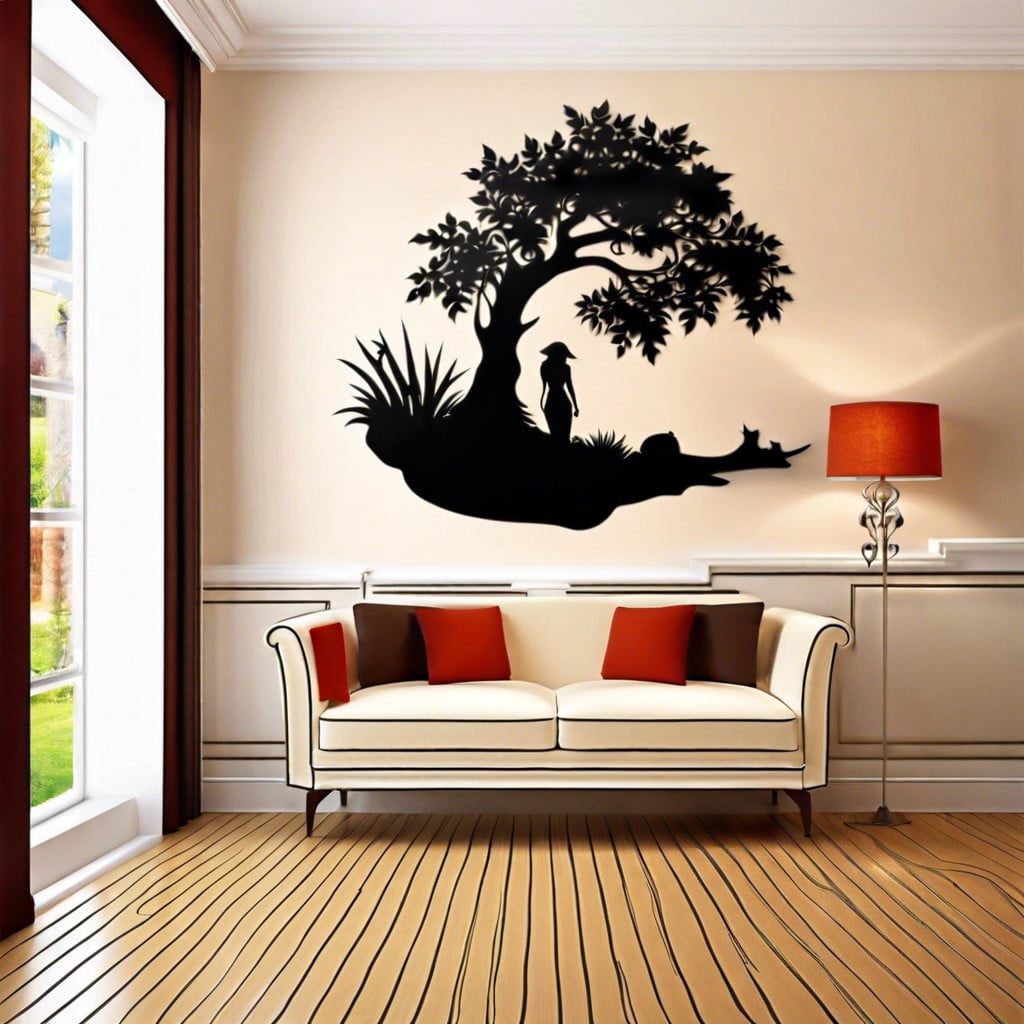
To make a statement on any wall in your home, experiment with overhead lighting or a projector. You’ll need to create or select a stencil design that represents your personality or coordinates with your room’s theme.
Clean and prep your wall before applying paint through the stencil while the light source is active. The resulting effect, when the light and dark hues mix, adds depth and intrigue.
Various considerations can enhance your project:
- Material: High-quality, durable stencil material ensures crisp edges and repeated use.
- Size: Match stencil size to wall space for proportional balance.
- Design: Simple shapes offer modern aesthetic, whereas intricate designs yield a classical feel.
- Color: Darker paint creates a pronounced shadow effect. Light shades are subtler.
- Lighting: Different bulbs (halogen, LED) project different shadow intensity and color.
Remember, consistency in paint application delivers a smoother finish. Enjoy the dramatic transformation this decor brings to your space.
Light and Shadow Floor Patterns
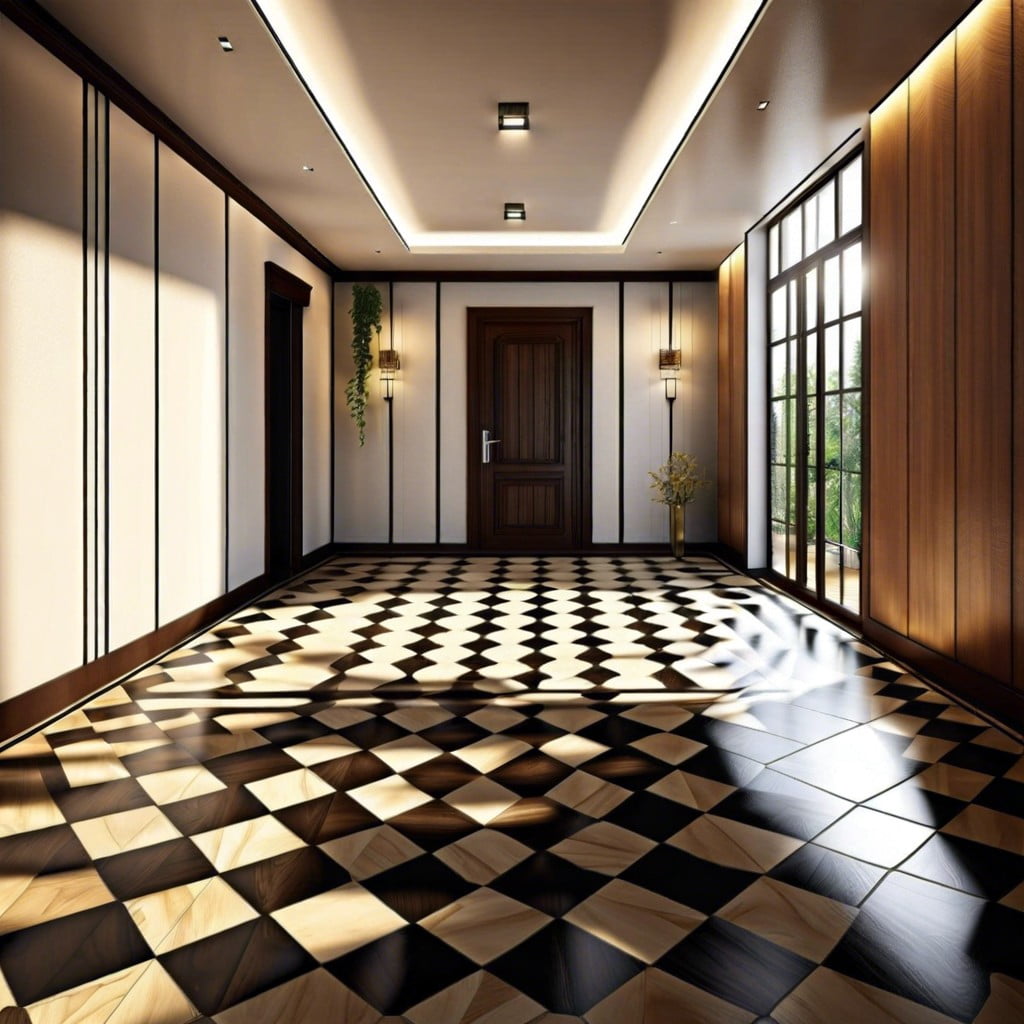
Incorporating a light source at the floor level can create intricate shadow patterns, giving a visually captivating aesthetic to the room. Here are ways to achieve this stunning effect:
1. Use Perforated Floor Screens: These can cast beautiful patterns on the floor when light shines through them. They’re both decorative and functional, serving as room dividers.
2. Install Projected Lights: These can cast patterns directly onto the floor. You can aim a light towards a stencil in front of the projector to create custom designs.
3. Implement Skirting Lighting: This is where lights are installed in the edges along the floor. The shadows will create a unique depth effect on textured floors.
4. Employ Transparent Furniture: Glass tables or chairs can bend and refract light, creating gorgeous shadows and highlights on the floor beneath.
5. Potted Plants and Hanging Baskets: The natural forms of plants can cast shadows for an organic, ever-changing pattern.
Remember, the goal is to use light and shadows creatively to add drama and depth to your space. The room’s size, natural lighting, and color palette should all be considered when designing your floor patterns.
Repurposed Wood Shadow Art
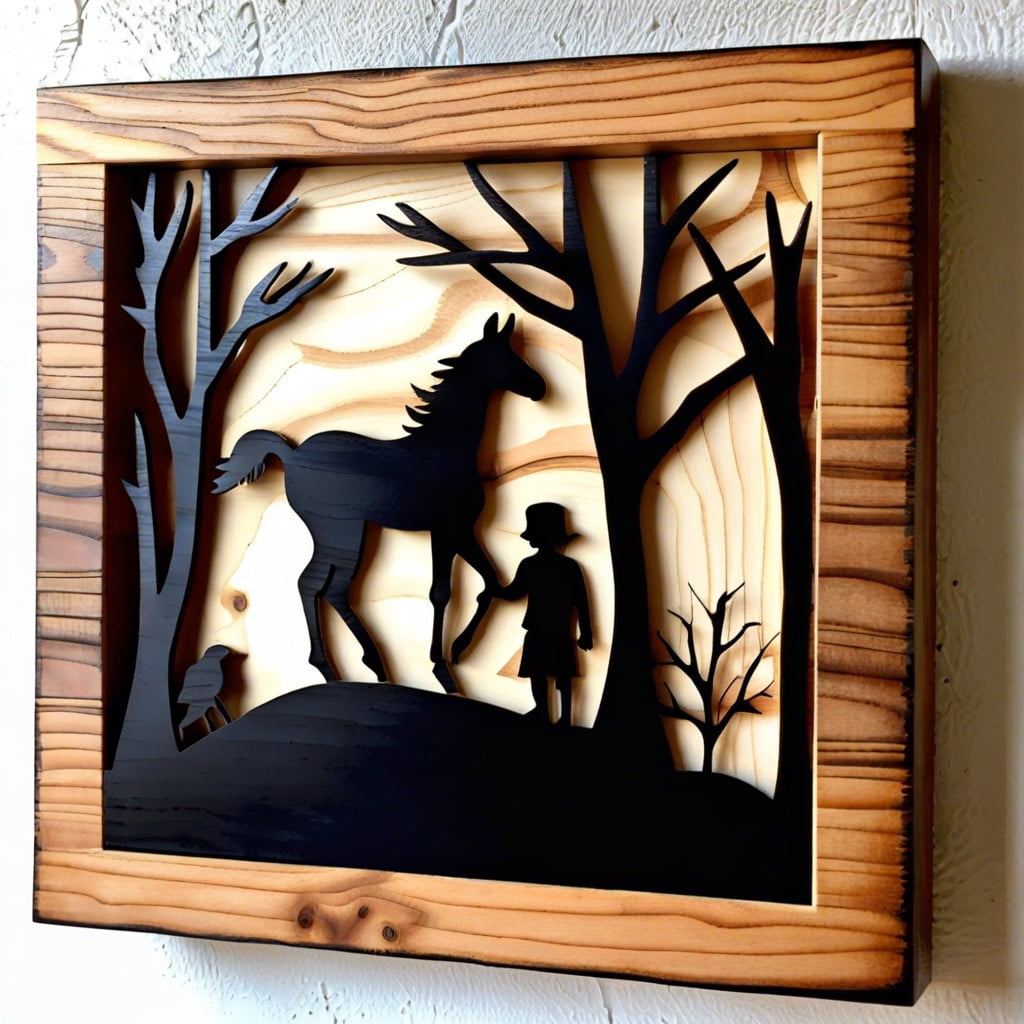
Repurposed wood gives a distinctive rustic charm to your home while playing with shadows to create eye-catching patterns. The unique grains and textures of worn-out wood add depth, allowing it to cast captivating shadow designs when well-positioned against the light.
1. Identify worn-out wooden pieces – anything from old furniture to discarded wooden boards can be used.
2. Strategically arrange the pieces on a blank wall space, considering how sunlight or artificial light hits them to cast compelling shadows.
3. Secure the pieces firmly to the wall for safety and to maintain the desired arrangement.
4. The final result should be an aesthetic shadow display when the lights hit the wooden pieces, a living decor that changes with the sun’s trajectory or the lights switched on.
5. Rotate, rearrange or add pieces occasionally to refresh the display and continuously capture your guests’ attention.
Emphasize on adaptability, feel free to explore different light sources and wooden materials to achieve the desired effect.
Negative Space Shadow Art
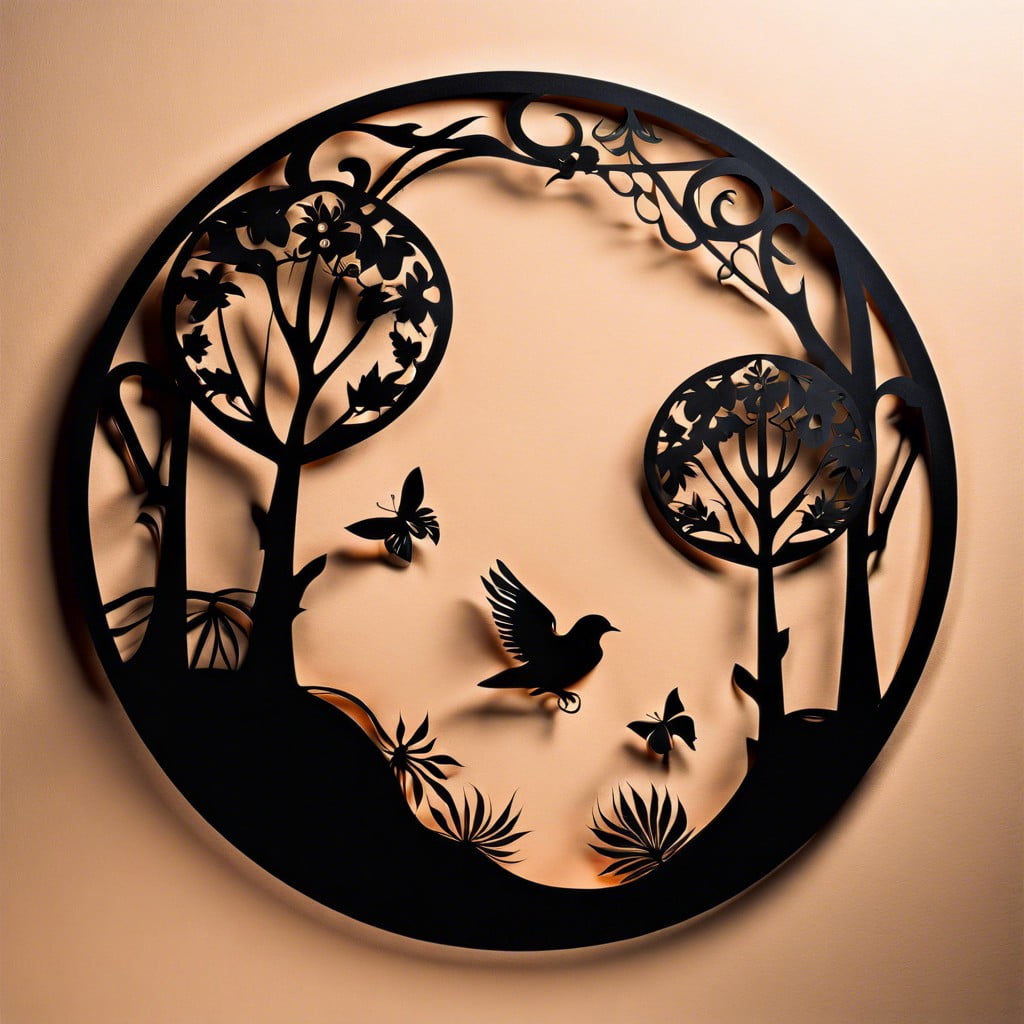
Negative space shadow art is a fascinating method of introducing contrast into your decor. It relies heavily on the interplay between light, shadow, and stark, uninterrupted areas, known as negative space. Here is how to approach it:
1. Choose Objects: Track down items with notable shapes. These don’t have to be conventional art or decor pieces – they could be everyday objects, such as cutlery, tools, or plants.
2. Set up the Arrangement: Position your selected objects in a way that the shadows they cast are striking and unique. Mind the distance and angle of your light source to achieve the best effect.
3. Use Contrast: Ensure the negative space remains untouched to create a stark contrast that highlights the shadow shapes. This interplay between darkness and light will create visual interest.
4. Experiment: There’s no hard and fast rule in creating these masterpieces. Freely rearrange these elements to achieve the desired effect.
Remember, the goal of negative space shadow art is not only about the shadows cast but the empty space around it. The contrast helps in establishing a visually appealing balance.
Shadow Effect Candle Holders
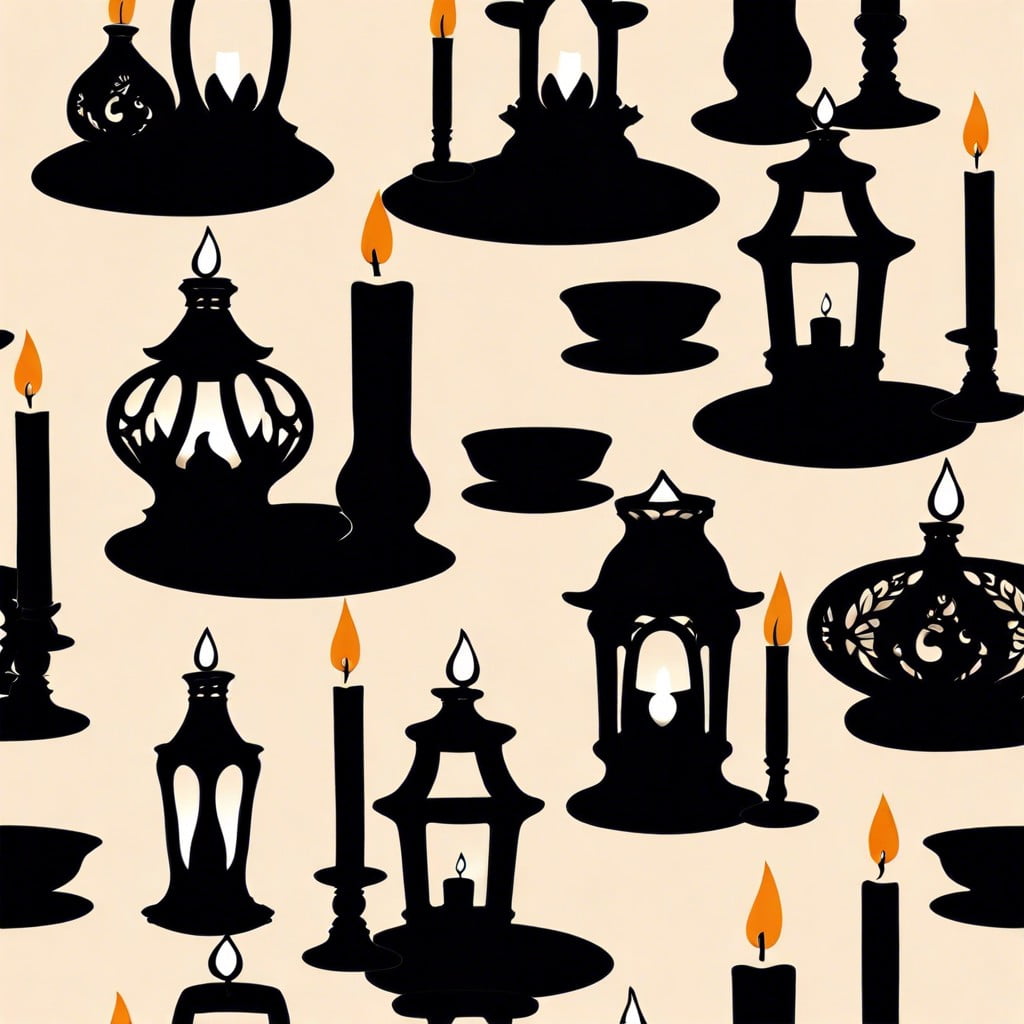
Manifesting an alluring play of light and shadows in your room is effortless with the right candle holders. Opt for visually interesting designs, such as intricate filigree work or abstract cut-outs, to cast shadow art on your walls. The softer the light source used, the more pronounced the shadow effect; hence, consider using tea light candles or delicate fairy lights.
It is also important to note the position of these candle holders. They can be hung from the ceiling or placed on a table depending on the desired shadow play. Experiment with different heights and angles to achieve the perfect look.
For a pop of color, use tinted glass candle holders, creating colored shadows around the room. This is another step in making your home a stylish hub, using just shadows and lights.
Shapes Cut-outs for Window Shadows

Crafting shapes for window shadows can be a fun project that delivers stunning visuals to your home.
Start by selecting sturdy material; cardboard or thick paper is ideal. Next, draw your chosen shapes onto the material. Opt for simple patterns or silhouettes for the best results.
After cutting out your shapes, affix them to your windows using a removable adhesive. Position the cut-outs so that they’ll catch the sunlight, casting their shape as shadows onto your walls or floors.
Remember, play with the sizes and positions of your cut-out shapes according to the layout of your rooms and the direction of sunlight. Different times of the day can dramatically change the look and feel of your shadow designs.
This DIY project not only customizes your home decor but also creates a dynamic visual effect that alters throughout the day.
Recap
